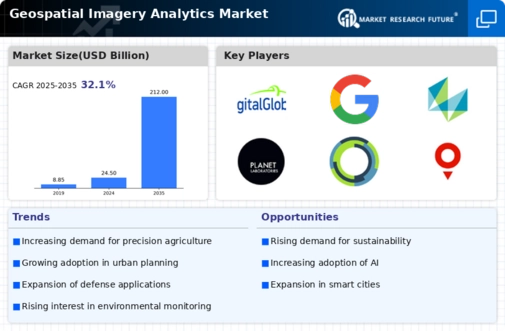Market Growth Projections
The Global Geospatial Imagery Analytics Market Industry is poised for substantial growth, with projections indicating a market value of 24.5 USD Billion in 2024 and a remarkable increase to 212.0 USD Billion by 2035. This growth trajectory suggests a compound annual growth rate (CAGR) of 21.67% from 2025 to 2035. Such projections reflect the increasing reliance on geospatial data across various sectors, driven by advancements in technology and growing applications. The market's expansion is likely to be fueled by the integration of artificial intelligence, remote sensing technologies, and government initiatives, positioning geospatial analytics as a critical component in decision-making processes globally.
Government Initiatives and Funding
Government initiatives and funding significantly influence the Global Geospatial Imagery Analytics Market Industry. Various governments worldwide are investing in geospatial technologies to enhance national security, urban planning, and disaster response capabilities. For instance, the United States government has allocated substantial resources to develop satellite systems that provide critical geospatial data for various applications. Such investments not only stimulate market growth but also encourage public-private partnerships, fostering innovation in geospatial analytics. As these initiatives gain momentum, they are likely to propel the market towards a projected value of 212.0 USD Billion by 2035, reflecting the increasing reliance on geospatial data.
Increasing Demand for Remote Sensing
The Global Geospatial Imagery Analytics Market Industry experiences a surge in demand for remote sensing technologies. These technologies enable the collection of data from satellites and aerial platforms, facilitating real-time monitoring of environmental changes, urban development, and disaster management. For instance, the integration of remote sensing in agriculture allows for precision farming, which optimizes crop yields and resource usage. As the global population continues to grow, the need for efficient land use and resource management becomes paramount, driving the market's expansion. This trend is reflected in the projected market value of 24.5 USD Billion in 2024, indicating a robust growth trajectory.
Emerging Technologies and Innovations
Emerging technologies, such as drones and high-resolution satellite imagery, are reshaping the Global Geospatial Imagery Analytics Market Industry. The advent of drone technology allows for the collection of high-resolution images at a fraction of the cost of traditional methods. This innovation is particularly beneficial for industries like agriculture and construction, where detailed imagery is essential for planning and monitoring. Furthermore, advancements in satellite technology are enabling more frequent and detailed data collection, enhancing the accuracy of geospatial analytics. As these technologies continue to evolve, they are expected to drive significant growth in the market, attracting investments and fostering innovation.
Growing Applications Across Industries
The versatility of geospatial imagery analytics drives its adoption across diverse industries, thereby propelling the Global Geospatial Imagery Analytics Market Industry. Sectors such as agriculture, transportation, and environmental monitoring leverage geospatial data for improved decision-making. For instance, logistics companies utilize geospatial analytics to optimize delivery routes, reducing fuel consumption and operational costs. Similarly, environmental agencies employ these analytics to monitor deforestation and track wildlife populations. This broad applicability not only enhances operational efficiency but also supports sustainable practices across industries, contributing to the market's robust growth trajectory.
Advancements in Artificial Intelligence
Artificial intelligence plays a pivotal role in enhancing the capabilities of the Global Geospatial Imagery Analytics Market Industry. AI algorithms facilitate the processing and analysis of vast amounts of geospatial data, enabling more accurate predictions and insights. For example, machine learning techniques are employed to identify patterns in satellite imagery, which can be crucial for urban planning and environmental monitoring. The incorporation of AI not only improves efficiency but also reduces operational costs, making geospatial analytics more accessible to various sectors. This technological advancement is expected to contribute significantly to the market's growth, with a projected CAGR of 21.67% from 2025 to 2035.























Leave a Comment